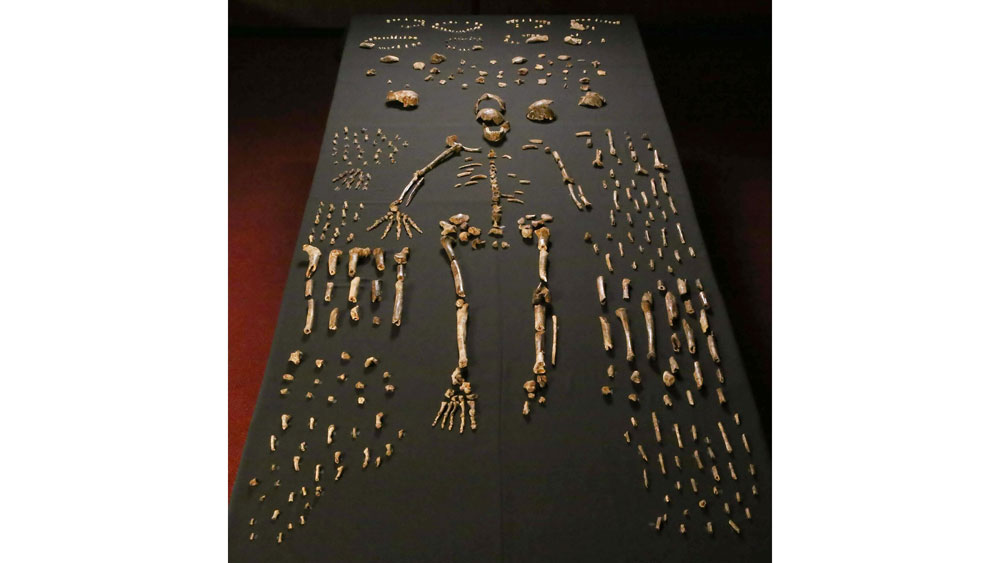A new study published in the Journal of Human Evolution has found that the so-called Homo naledi most likely didn’t bury their dead as previously proposed.1 Furthermore, the team of scientists concluded that Homo naledi probably didn’t use stone artifacts, make fire, or create cave art as has been suggested by paleoanthropologist Lee Berger.1
A few months ago, Lee Berger and his fellow scientists published several papers claiming the so-called hominin known as Homo naledi buried their dead and carved cave art on the walls of the Rising Star Cave system in South Africa.2,3,4 However, the new report by Martinón-Torres et al. was quick to point out that these claims were not backed by sound science, stating, “Here we argue that the evidence presented so far is not compelling enough to support the deliberate burial of the dead by H. naledi nor that they made the purported engravings.”1
The new study re-evaluated the skeletal arrangements of Homo naledi in the Rising Star Cave system, concluding:
From the evidence presented, the skeletons found at the Rising Star Cave are not articulated and therefore a reliable reconstruction of the original position of the bodies/body parts cannot be assessed, especially as some remain unexcavated…it is impossible to evaluate the degree of completeness of the body/bodies, their original position and the limits of the purported excavated pit. In the absence of this information, the claim for deliberate burial must be rendered premature at this stage.1
In addition, the authors note that Berger’s team seemingly dismissed any possibility that the bones could have been scattered by water transport even though significant amounts of water did flow through these cave chambers.5,6 Instead, they chose a less parsimonious explanation and stuck with it.
Martinón-Torres et al. added, “The authors [Berger’s team] have built a misleading, but persuasive discourse, where they do not test their hypothesis but selectively report the evidence that supports their preferred scenario.”1
A better explanation for these scattered bones is that they were simply washed into the cave system during a post-Flood (possibly Ice Age) catastrophic flood event.7 Evidence suggests that the so-called H. naledi neither disposed of their dead nor buried them.
One of the chambers contained a stone artifact that Berger’s team claimed may have been a stone tool used by H. naledi.2,3 However, Martinón-Torres’ team pointed out that this so-called “tool” was just a piece of dolomite (magnesium-calcium carbonate) that likely spalled off the wall of the cave. Furthermore, they noted that a dolomite tool is unlikely to begin with since it is not durable like chert or flint tools.1 They wrote, “Despite previous claims, no evidence that H. naledi might have made Acheulian and/or Middle Stone Age stone tools has been made available to date.”1
Berger’s science team has also suggested that H. naledi used fire to transport the dead into the caves.4 This also has no scientifically verifiable evidence.1 Many other caves contain charcoal and burned material that could have been transported in naturally like the bones themselves.1 Martinón-Torres’ team concluded, “As with the ‘stone tool’, without any scientific evidence backing up this claim, the possibility of use of fire by H. naledi cannot be minimally considered and remains entirely speculative.”1
This past summer, Berger’s team also claimed that H. naledi likely made rock art engravings on a pillar in the cave.3 These “etchings” resemble various geometric shapes like triangles, squares, and crosses.3 But natural weathering processes have been found to create many such geometric shapes elsewhere.1 These “etchings” are most likely the product of differential erosion along natural fractures in the dolomite pillar. Likely few geologists would consider these geometric designs to be rock art. Also, some of the more unusual carvings seemed to better match animal scratches and possibly cave bear marks than rock art.1
Even Berger’s claim that the cave chambers containing H. naledi bones were not readily accessible, and therefore not previously disturbed, is dismissed by Martinón-Torres’ group.1 They point out that humans have been visiting the caves of the Rising Star Cave system since the 1960s, including the Dinaledi Chamber where most of the skeletal remains are found.1 In addition, they noted that there were survey pegs and re-arranged bones in the cave chamber even before the first person was supposed to have visited the site.
In conclusion, Martinón-Torres’ team wrote, “There is no convincing scientific evidence to indicate that H. naledi buried their dead and produced rock art in the Rising Star Cave system based on the information thus far presented.”1 They added:
In the case of Rising Star Cave, it is clear that the evidence that would demonstrate that H. naledi buried their dead and made art has not yet been presented despite [the fact that] this notion has been openly shared with the public…We should not mistake open science with open opinion, where social media, outreach events and blogs are considered scientifically valuable and more appropriate vehicles for knowledge growth.1
We agree. Science should be based on observable data without jumping to unsupported conclusions.
ICR scientists have previously concluded that Homo naledi was most likely an ape and that the skeletons are even possibly part of an assemblage of bones from more than one ape species.8,9 Simply put, H. naledi did not exhibit human behavior because it was not human.
Humans and apes were created on Day 6 of the creation week, but that’s where the similarities end. Since the beginning, apes have always been apes, and humans have always been humans.
References
-
Martinón-Torres, M. et al. 2023. No scientific evidence that Homo naledi buried their dead and produced rock art. Journal of Human Evolution, https://doi.org/10.1016/j.jhevol.2023.10
3464. - Berger, L. R. et al. 2023. Evidence for deliberate burial of the dead by Homo naledi. eLife. 12: RP89106.
- Berger, L. R. et al. 2023. 241,000 to 335,000 years old rock engravings made by Homo naledi in the Rising Star Cave system, South Africa. eLife. 12: RP89102.
- Fuentes, A. et al. 2023. Burials and engravings in a small-brained hominin, Homo naledi, from the Late Pleistocene: contexts and evolutionary implications. eLife. 12: RP89125.
- Dirks, P. et al. 2015. Geological and taphonomic evidence for deliberate body disposal by the primitive hominin species Homo naledi from the Dinaledi Chamber, South Africa. eLife. 4: e09561.
- Dirks, P. et al. 2017. The age of Homo naledi and associated sediments in the Rising Star Cave, South Africa. eLife. 6: e24231.
- Clarey, T. L. 2017. Disposal of Homo naledi in a possible deathtrap or mass mortality scenario. Journal of Creation. 31 (2): 61–70.
- Clarey, T. 2018. Homo naledi Bones Not Ritually Buried. Creation Science Update. Posted on ICR.org May 17, 2018, accessed November 24, 2023.
- Tomkins, J. P. 2020. Homo naledi: Another Failed Evolutionary Ape-Man. Acts & Facts. 49 (1): 10–13.
Stage image: Dinaledi skeletal specimens
Stage image credit: Copyright © Lee Roger Berger research team, 2015. Used in accordance with federal copyright (fair use doctrine) law. Usage by ICR does not imply endorsement of copyright holder.
*Dr. Clarey is Director of Research at the Institute for Creation Research and earned his doctorate in geology from Western Michigan University.





















